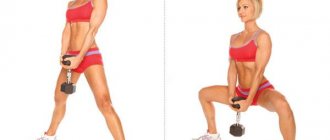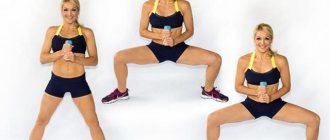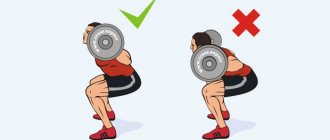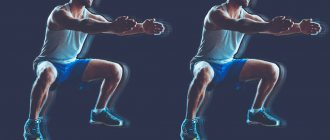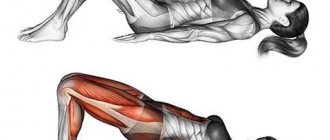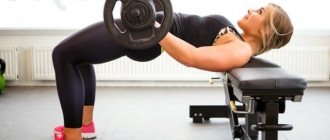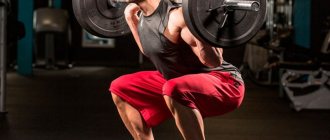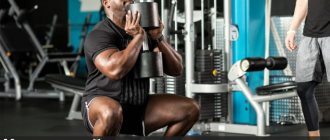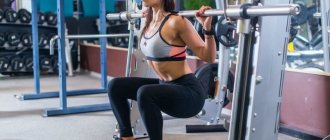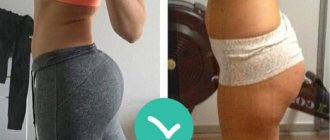Share:
What you need
- dumbbells
Plie squats with dumbbells are a fairly simple exercise at first glance aimed at working the inner thigh. It is very popular among girls who visit fitness clubs, as it helps to quickly get rid of excess fatty tissue on the hips and get them into shape, but it will also benefit men involved in strength sports.
The exercise requires good stretching and coordination, without which you will experience discomfort when performing it.
The exercise is not without its pitfalls, which we will talk about today. It is recommended to do it in a fairly large repetition range, so you can fully feel the effect. The weight of the dumbbell should be moderate; you should not climb to record weights.
Today we will tell you the benefits of plie squats with dumbbells and how to do them correctly to get the maximum benefit from the exercise.
Why squat like that?
The most valuable benefit of weighted plie squats is the pumping of the buttocks and inner thighs. Moreover, by varying the depth of the squat, you can use more of the buttocks or quadriceps of the legs. This is relevant for girls who want to pump up their buttocks without particularly increasing the massiveness of their legs. We’ll tell you how to achieve both of these a little later.
Anyone who has already been to the gym knows how girls work on the problematic inner thigh - in a machine for bringing and spreading legs. So, plié needs to be done before this. This is the main exercise for local development of the inner thigh. Then you should get on the simulator. The exercise is designed for dumbbells or weight plates.
What muscles work?
First of all, such squats effectively load the hips and buttocks, namely the gluteus maximus, quadriceps, hamstrings and, very importantly, the inner thighs. In addition, stabilizer muscles such as the calves, quadratus lumborum and the muscle responsible for straightening the spine work. Thus, plie squats, which muscles work in which, you can see in the photo below, are an effective tool for working out the lower body.
Preparing for the exercise
Have you seen girls in the gym who, with their legs spread wide and holding a dumbbell above the floor, squatted? This is what plié is. For those who haven’t seen it, be patient, everything will be described in detail in the “execution technique” section.
- Stretching is the most important thing in the plie squat. The fact is that you will not be able to turn your knees normally or squat deeply enough if your ligaments are not ready for such an amplitude of movement. Therefore, next we will analyze what and how to pull so that the technique is close to ideal.
- Cloth. A separate conversation about pants. They should not restrict your movements. You need to choose clothes in which you can do the splits. Haven't sat down yet? Everything is ahead, don't be upset.
- Shoes must be stable and have hard soles. If you have weightlifting shoes, you can wear them.
How to improve your results when performing plie with a dumbbell
When performing plie squats with a dumbbell, you should pay attention to some subtleties that will help you achieve better results. It must be remembered that when performing the exercise, the back should remain straight and the dumbbell should be located close to the body.
It is best to perform squats smoothly, avoiding jerks.
In some cases, when encountering plie squats for the first time, it can be difficult to maintain balance while performing the exercise. For confidence and skill acquisition, you can lean against the wall while squatting.
Particular attention should be paid to the knees; when squatting, it must be remembered that the direction of the knees must strictly coincide with the direction of the feet. Before performing squats with dumbbells for girls, experienced trainers recommend warming up
Features of stretching before squats
To perform the exercise correctly, you need to stretch the ligaments of the legs and lower back. We pull the lower back in the classic way - we reach the floor with our hands on straight legs. Here's another good way to stretch your lower back: sitting on the floor. Details in a special article on back stretching.
Leg stretching is best done on a wall bars. Walk up to her and raise your leg as high as you can. Straighten your leg. Bend in different directions, stretch the ligaments. Fix your body in those positions where you experience barely noticeable pain. There is no need to go further.
Sit on the longitudinal and transverse splits. Also, one of the main ways to stretch in this case is to sit on the floor, spread your knees to the sides, and reach them to the floor. Press with your hands from above until your knees touch the floor.
Exercise technique
The most important thing is to learn how to sit down correctly. Let's start training with the minimum weight that you have in your gym or at home. Let it be a 1 kg dumbbell that you can comfortably grip with your hands.
- We take the dumbbell with both hands so as to hold it by one of the edges. The dumbbell should hang freely perpendicular to the floor, the bar passes between the fingers.
- Place your feet with your toes apart, as if you were a ballerina. Only they place their legs almost together, and you place them a little wider than shoulder-width apart. Turn your socks out to the sides as much as possible. The more the toes are turned out, the more stress will be placed on the inner thigh. In particular, the position of the feet of plie differs from sumo (in sumo, the socks turn about 45 degrees).
- We straighten our back, move our pelvis back a little, creating a natural deflection in the lower back.
- We look slightly upward (usually they suggest looking at the line between the ceiling and the wall that is opposite you).
- We begin to lower the pelvis down. Keep your knees pointing in the same direction as your feet (which is why we warned you that a good stretch will be needed). We squat to the maximum - below parallel with the floor. We don’t swing dumbbells back and forth!
- After reaching the bottom point, we begin to get back up. We go down as we inhale, we rise as we exhale. It is important that the movements are smooth.
- We don’t fully extend our legs! You need to maintain muscle tension throughout the exercise.
- The weight is kept perpendicular to the floor between the legs at all times.
The exercise technique is not the most difficult, but a lot of mistakes are made.
Mistakes and how to avoid them
Do you lean forward too much? This happens when you back squat because you are afraid of falling. In this case, you are also afraid of falling. What to do: Place a bench behind you so that you can sit on it as you move down. This will give you confidence and you will remember how to move. Then remove the bench and try squatting lower.
Other errors:
- The knees “walk” from side to side. This occurs when you lack stretching or have weak knee ligaments. Or you haven't spread your feet far enough and are trying to turn your knees even further. The solution is stretching and coordinated work of the knees and feet.
- Looking at the floor. You just need to keep your head straight, or slightly up.
- The dumbbell in your hands dangles between your legs because you strain your arms too much (at first it goes forward, and when your arms get tired, it goes back). Remember, gravity is working for you, it will align your weight perpendicular to the floor. Let Mother Earth do it for you.
- If you don't stand wide enough, your knees may go beyond your feet. It is not recommended to do this in a squat.
- Your legs are fully straightened at the top. This is not recommended, as the muscles relax, but the effectiveness of the exercise decreases. Watch the position of your legs - they should be bent (slightly to maintain tension).
- Shallow squat. The meaning of the exercise is lost when you perform the exercise with a small amplitude. In this case, you use only the front and outer thighs and pump only them. And for this there are special exercises, for example, a front squat. The internal part begins to work when you drop below parallel with the floor.
- This is not a sumo deadlift, so you need to work with your legs, not your lower back. Pay attention to this!
Climb
You have to focus on one word: tension.
One of the most common mistakes people make while lifting is relaxing a part of their body (upper back, abs, or grip of the bar).
You are only as strong as your weakest link. When one part of the body stops working at its full capacity, it becomes more difficult to complete the exercise.
For example, if you relax your upper back and chest halfway through a heavy rep, you will lose speed and likely end up leaning forward. Therefore, other muscles will be forced to work even harder to align, and if they fail, the set will simply end.
That's why most tips to help you rise encourage you to stay on your toes.
For example, here are some helpful tips to keep things on your toes:
- Fire upward sharply after reaching the desired squat depth.
- Move during the lift as if you were trying to throw the barbell off your back. This will help speed up the rise.
- Imagine that you are pushing the floor apart with your legs. Guide your hips under the bar.
You may have noticed that there is a point just above parallel where, as you lift, the weight suddenly becomes much heavier and the speed begins to slow down. (If this makes you feel better, know that it happens to all elite powerlifters).
The keys to getting past this point are to start the lift with an explosive movement, hold air in your lungs, and drive your hips powerfully under your body.
Before we move on, let's look at a common problem people have when lifting: rounding the back.
Useful tips
Squat in front of the mirror. You must see yourself. It is clear that you can see better from the side. Believe me, looking at yourself in the mirror, you can also see many mistakes and correct them.
And:
- Don't chase the scales. The inner thighs are easily injured and take a long time to heal. Always warm up with light weights before moving on to heavy weights.
- You can use a weight plate instead of a dumbbell. The only negative is that it is not as comfortable to hold in your hands as a dumbbell. But there is a way out - attach it to a special weight belt. Thus, you can significantly increase your working weights, completely freeing your hands. But you will need to study on platforms (read about this below).
- If your knees hurt, you can try using elastic bandages. In some cases, this does not help, since the squats are deep, and at some point there may still be pain. Focus on how you feel. If you notice a tendency towards increased pain, do not argue with your body - work on a leg abduction machine.
- If during a squat you feel slight pain in the inner thigh, stop doing the exercise immediately! Working through pain will lead to injury. While you are warmed up, the pain is not so severe and you will not realize how much you have damaged the muscle. We recommend that you do not do any exercise that causes this pain for several days. Then try again, or better yet, consult a doctor.
Advantages
The plie squat is both an additional, final exercise for pumping large muscles, and independent, replacing squats with weights or jumps. When done correctly, it has a number of advantages:
- the plie exercise is considered the least traumatic;
- using the adductor muscles of the legs, it purposefully works and tightens the inner thighs, which are difficult to reach compared to other types of training;
- plie with dumbbells for girls allows you to avoid overstressing the quadriceps of the thigh - compared to classic squats, the front part is less loaded;
- tighten the buttocks, making them more rounded;
- do not load the spine, does not injure the knee joints, provided the correct technique is followed, therefore suitable for people with back injuries;
- makes joints and ligaments more mobile, elastic, stronger;
- improve coordination of movements;
- improve blood circulation in the pelvic organs;
- allow you to use any convenient type of equipment during training;
- due to its ease of implementation and minimal load on the spine, it is ideal for home workouts, including for pregnant women.
Plie is popular among girls who visit fitness clubs, as it helps to quickly get rid of excess fatty tissue on the hips and get them in shape.
Difference from sumo squats
This exercise is often confused with sumo - the two techniques are similar to each other, however, there are significant differences in the degree of load distribution and method of execution:
- when performing sumo, the inner thighs are worked out less intensively compared to plie;
- in sumo, the athlete uses more weight than in plie;
- sumo squats involve moving the pelvis back, reaching the bottom point with the torso tilted forward, plie is performed with a straight body;
- Plie requires a wider stance of the legs.
Exercise options
If you want to maximally target your glutes, you need to do a deep squat. It is simply impossible to achieve this while standing on the floor. The weight will hit the floor before you reach the lowest point in the exercise.
There is a version of plie squats on platforms. Their height is different. If you have good stretching, you can safely squat on such platforms.
Technique:
- Position the platforms so that your feet are stable on them in your starting position.
- You can use a dumbbell, but even better - a belt with the ability to weigh it down with weights. This option is more likely for men with good training. You can lift 45 or 60 kg (yes, men also do this exercise as an addition to a regular squat).
- We begin to slowly descend to the highest possible point. We watch our knees so that they do not go to the sides and do not jump over the edge of the foot.
- You can linger at the bottom point for 1–2 seconds. Let's go back. We don’t stop at the top – as soon as we reach it, we immediately go down. Perform the required number of repetitions.
If there is no platform, take large pancakes and place them on top of each other. This way you can set the desired height, reduce or increase it if necessary.
Use 2 benches placed side by side. This option is suitable for low-budget halls. At home, take two low stools or chairs (just make sure they are stable).
What happens if you squat only this way?
Definitely, you will strengthen the inner and front part of the thigh, buttocks. You may get a slight increase in muscle mass. Remember, in order for muscles to grow, they need to be stressed. And the plie version is not designed for such weights. Therefore, this exercise cannot be called basic in the literal sense.
Even the ideal execution technique will not give you muscle growth, this is a myth, remember! Only the classics in combination with progressive loads will give you volume. This is important for those who want to pump up something (buttocks, for example), and not just tighten muscles and tone everything.
It is recommended to perform this exercise in combination with squats with a barbell and leg raises in the machine.
Use the right equipment
- Shoes should have hard soles, durable and comfortable. The best option is weight lifters.
- Knee pads. Very often it is not recommended to use elastic bandages. Because they accelerate the wear and tear of the knee joints. Knee pads in this sense are the ideal solution. Unlike bandages, they give the joint stability, support, retain heat (heated tendons and ligaments stretch more easily) and do not put excessive pressure on the joint.
- Weightlifting belt. Numerous sports studies show that the belt improves your performance in squats and deadlifts, but, unfortunately, does not reduce the risk of back injury. Most athletes will 100% confirm that if you use a weightlifting belt correctly, you become stronger. Your results, although not very significantly, increase.
